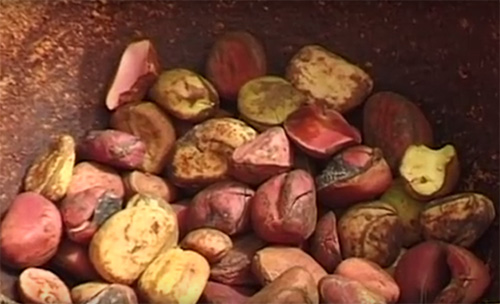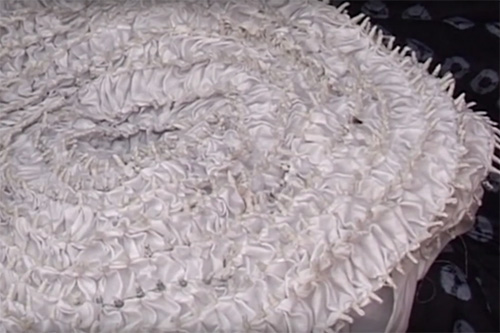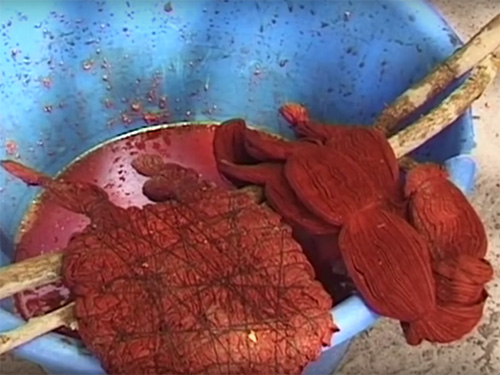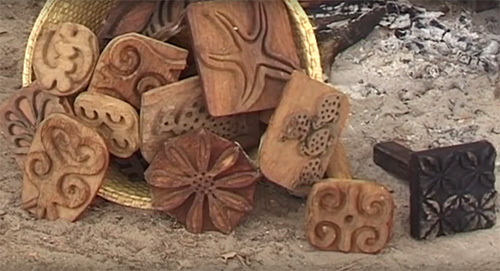 African craftsmen work hard to make the most extraordinary dyed patterns on the fabric. The method is called “tie-dye”. The process itself is rather simple – you can even try to hand dye your clothes at home using this technique. But we’d like to show you how Africans originally tie-dye the cloth, leaving their traditional patterns on it. The act is mesmerizing.
African craftsmen work hard to make the most extraordinary dyed patterns on the fabric. The method is called “tie-dye”. The process itself is rather simple – you can even try to hand dye your clothes at home using this technique. But we’d like to show you how Africans originally tie-dye the cloth, leaving their traditional patterns on it. The act is mesmerizing.
The Gambia is a tiny country on the west coast of Africa where the tradition of dyeing and platinum cloth goes back several generations. Natural colorless and indigo dyes continue to be used today, in spite of the introduction of chemical dyes in the 1970s and the popularity of imported factory-made cloth. Indigo blue dye is used throughout the world and is well known and well researched. In contrast, the rich orange-brown kola nuts dye is found only in West Africa. Although the kola nuts trade is well-documented, very little is recorded about kola nuts dye. Kola nuts come from the tree “kola nutida”; it is cultivated in the forests of several West African countries since kola nuts are an important trading commodity.

Kola nuts used to make a natural dye
For centuries, kola nuts have been used as a stimulant and are chewed to counteract tiredness, thirst, and hunger. Today, they're still widely used in Gambia for gifts and at ceremonies. The old nuts that are not suitable for chewing are sold off cheaply and used for dyeing cloth. The main center of kola nuts dying is Sukuta, a small town close to the capital Banjul. Most of the traditional dyers using kola nuts come from the Serer ethnic group.
This is a Serer compound in Sukuta where the kola nuts dye is being prepared – the kola nuts (or guru) are being pounded in a wooden mortar and pestle. The crushed nuts are saved, tipped into a large bowl, and mixed with water to make a thick, brilliant, orange-colored mixture. No other chemicals or substances are added. The dye bath is ready for immediate use.
The craftsman prepares the cloth for dyeing by folding it and tying it in various ways. He uses imported cotton cloth, cut into 3-meter lengths. He can prepare more than 40 pieces in one dye session.

Cotton cloth tied in small knots and prepared for the dying process
Here he is preparing a traditional disk or circle design. After wetting the cloth, and marking the positions of the circles, he anchors the cloth with a heel of his foot and then starts pleating it. The pleated circles are bound tightly, using cotton thread bought from the local market. The dye will not be able to penetrate these tied-up areas of the cloth. When the circles are tied, he crumples the rest of the cloth against his leg. After dyeing, it will have a mottled background. Cotton cloth can be tied in many different ways.
The traditional cloth seller sits in the market, tying cloth in small plumps to make patterns – tiny circles.
The craftsman begins dyeing the tied cloth. He dips each piece repeatedly in and out of the kola nut dye bath. They are left to drain overnight. By the next day, they have turned a deep orange-brown.

Dyed pieces of cloth after the kola nut dye bath
To finish the dyeing process, the kola dyed cloths are overdyed in the indigo blue dye. They are dipped several times in the indigo fat. This is a large oil drum full of dark smelly greenish-blue dye.
After dyeing, the cloths are rinsed, the threads cut, revealing the beautiful patterns. The indigo blue has mixed with a kola orange to make a whole range of subtle blues, greens, and dark browns.
Indigo dye has been the most popular and common source of coloring cloth throughout West Africa for centuries. Preparing the dye is a complicated process taking several days. Exact details of the recipe are kept a family secret.

Indigo dyed fabric with various patterns
Traditionally, leaves of the indigo plant are pounded into balls which are soaked and mixed together with caustic soda and a liquid made from the roots of the local wonder bush.
The craftsman tests to see if the dye is ready by checking its taste and its color.
The cloth dipped in the indigo dye will appear green when it is first taken out. It will only start turning blue when it reacts with the oxygen in the air. The more times the cloth is dipped in and out of the dye, the darker the cloth will become.

Carved wooden batik stamps which are used to make resist patterns on the fabric
The craftsman also uses carved wooden batik stamps dipped in hot candle wax to make resist patterns on cloth. The stamps are made from teak wood by local wood carvers. Firstly, ordinary household candles are melted in a shallow metal bowl over a wood fire. The wooden stamp is dipped in the hot wax and then pressed firmly on the cloth. This cloth will have patterns made of an African cone design. The dye cannot penetrate the wax, so white patterns will be made wherever the cloth has been stamped.
The next day, the cloth is stamped again with hot wax in places where orange patterns are wanted. The craftsman now dips the waxed cloth several times into indigo blue dye, until the background has turned a deep black color. The waxed patterns remain orange and white since the blue dye cannot get through those waxed areas of the cloth.

Almost ready for sale tie-dyed fabric
To remove the wax, the cloth is dipped into a pan of boiling water, lifted out with a stick, and plunged immediately into cold water, where it is rubbed hard to remove any remaining wax.
Before the cloth is taken to the market, it is ironed in the traditional way – by beating it with heavy wood clubs. These are made of mahogany and can weigh up to 3 pounds each.
(c) Anita Whittle


